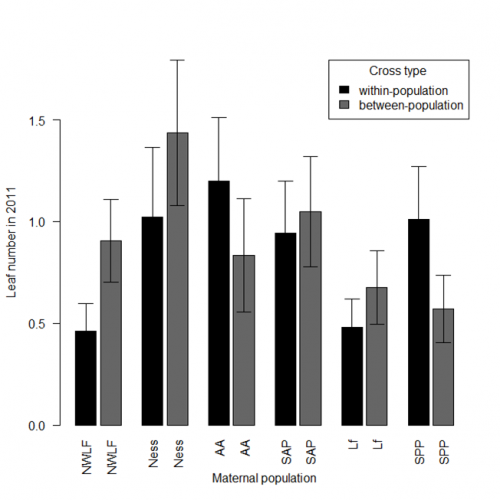Today Brad and I finished the 2015 census on my crossing experiment plot.
The plants in this plot are the offspring of within-population or between-population crosses of Echinacea plants from six nearby prairie remnants. In most cases, the pollen for between-population crosses was supplied by the largest prairie remnant in the experiment, identified as SPP in the figure below. Crosses were made in the summer of 2008 (thanks to LOTS of help from Team Echinacea). We sowed a total of 15,491 achenes into this plot in the fall of 2008. We estimated that about 40% of the achenes contained embryos, based on their weights.
In the spring of 2009, we found 396 seedlings. We found an additional 43 seedlings in late summer, 2009, and another 10 new seedlings in the summer of 2010. In 2011, we were only able to find 264 of these plants, and the numbers have continued to decline: we found 185 in 2012, 124 in 2013, 112 in 2014, and 89 this summer (2015). We have yet to observe any flowering!
 As you can see from the graph (based on results through 2011), results of within- and between-population crosses have been mixed. The columns in the graph represent estimated mean total leaf number for each cross, for a starting number of 25 achenes, based on an analysis of total fitness (using an aster model). The main effect of cross type was non-significant; however, there was a significant effect of maternal population, and a statistically significant interaction between maternal population and cross type. In other words, the success of the type of cross depended on the maternal plants that were crossed. For the smallest population (identified as NWLF), offspring of between-population crosses outperformed within-population crosses. For the largest population (SPP), the within-population crosses performed better than the between-population crosses.
As you can see from the graph (based on results through 2011), results of within- and between-population crosses have been mixed. The columns in the graph represent estimated mean total leaf number for each cross, for a starting number of 25 achenes, based on an analysis of total fitness (using an aster model). The main effect of cross type was non-significant; however, there was a significant effect of maternal population, and a statistically significant interaction between maternal population and cross type. In other words, the success of the type of cross depended on the maternal plants that were crossed. For the smallest population (identified as NWLF), offspring of between-population crosses outperformed within-population crosses. For the largest population (SPP), the within-population crosses performed better than the between-population crosses.
What implications can we draw from these results? In some cases a small, inbred remnant population may be enhanced by cross-breeding with another local population (this is called “genetic rescue”). However, between-population crosses also run the risk of outbreeding depression, as we have observed for the SPP-Lf cross, compared to the SPP-SPP within-population cross.
We now have 4 more years of data, with quite a bit of mortality. It will be exciting to perform another analysis including more data!
